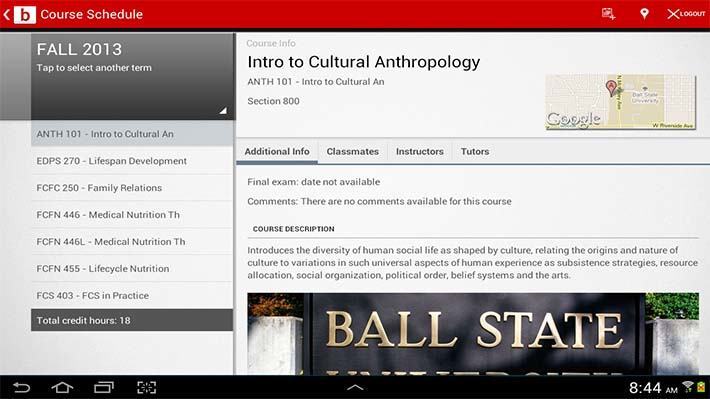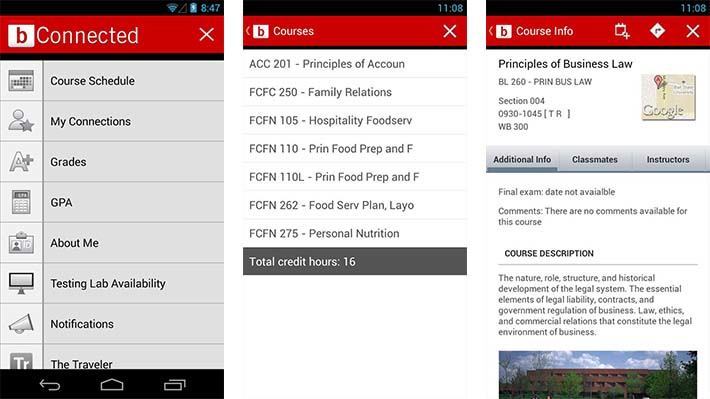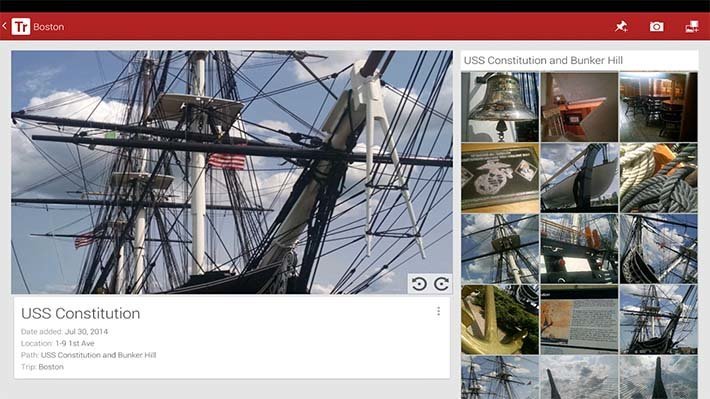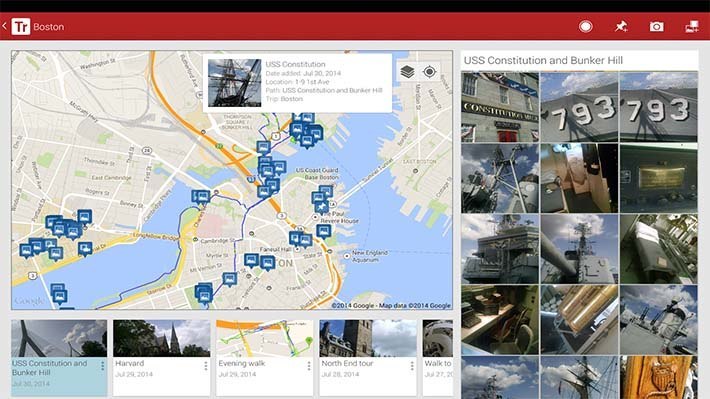Affiliate links on Android Authority may earn us a commission. Learn more.
Meet the Devs - Kyle Parker
Published onNovember 11, 2014

Name: Kyle Parker
Developer Name: Kyle Parker
Country: United States
Website: N/A
Google+ Profile/Page: Kyle Parker G+
How many people on your team? 3

Apps
About your company?
I work at Ball State University, in Muncie, Indiana, and lead a small group of developers. The “official” description of my group is:
Part of Information Technologies Services at Ball State, Developing Technologies is focused on providing innovative, creative and out of the box ideas and skills to drive the next generation of data-driven web, mobile, and desktop experiences for students and faculty. The ultimate goal is to reduce the hassle factor for students. We aim to knock down and break through the walls that separate students from the academic and institutional data and services they rely on each day, while offering a rich and immersive experience.
The unofficial description is we are a creative, R&D group that has the exciting opportunity to work with the latest and great technologies to create cool apps for our students. And with our latest app – The Traveler – we were able to create something for a worldwide audience. With over 100,000 downloads in 200 countries, an official Glassware for Explorers, and mentions from Samsung, LiveMint.com, Lonely Planet and dozen other sites around the world, Traveler has become a huge success for us. Not to mention the 30 countries and 5 continents our students have visited using Traveler, while recording over 100,000 miles of paths, 25,000 media items, and almost 80GB of data.
What level of experience do you have with coding and development?
I graduated from Ball State University with a BS in computer science in 2000. Immediately after graduation, I began working at my alma mater as a developer in our central IT department. My career started in the web, where I focused on designing, developing, integrating, and enhancing our content management system, built on the Vignette platform. Right away, I had the opportunity to work on a campus-wide system that touched every aspect of the university. We were able to integrate course information for the students; employee information for faculty and staff profiles; and events for calendars. The admin site and page templates were initially built using TCL (pronounced “tickle”) and a Sybase backend database. After the first couple years, I rewrote everything using Classic ASP and migrated to Microsoft SQL Server. As the primary developer for the CMS (and for the most part, the sole developer!), I learned how to architect a complex, multi-tiered system; manage over 200 users across campus; and support the system that powered the university public-facing web site.
After spending several years on the CMS, my role gradually evolved and I began working on the various enterprise web apps for our student and employee services, such as undergraduate admissions, reporting, intranet apps, and more than 50 other apps. Initially our apps were built with Classic ASP and MS SQL Server, then we migrated to ASP.NET (C#). Using all of the past experiences from designing, developing, and supporting our app catalog, a co-worker and I created the foundation and architecture for the .NET environment. We developed a robust framework of methods and procedures for the staff to use as we moved forward with .NET.
For the past three years, I have been focused on mobile, specifically Android. My role transitioned from the enterprise to the sandbox – I spend my days creating, designing, and imagining “cool” apps that our students can use on the device they have in their hands every single day. It is a great position to be in, and has been a rewarding and exciting challenge to learn and experiment with the latest and greatest technologies. My office looks like a Best Buy showroom – dozens of tablets; phones from the Original Droid to the Nexus 5, MAXX and Note 3; a smart TV; a couple Chromecasts; 3 pair of Google Glass; and thanks to I/O, the new Samsung Gear Live!
What languages do you know? How and where did you learn them?
The common thread throughout my years of development is “self-taught”. While college provided a foundation in CS, all of the languages I’ve learned have been on the job or for fun. I’ve learned by doing – scouring the web for examples of cool sites or apps; reading books and practicing with examples; or diving head first and hacking to see what I can pull together.
As I mentioned earlier, my languages include: Android and Java, Classic ASP and ASP.NET, and MS SQL Server/T-SQL. I’ve dabbled with iOS and HTML5, but wouldn’t consider myself an expert at this point. My experience doesn’t have the breadth of others, but I love digging into a language and learning all I can about it.
What level of experience do you have with design?
While I’m not a professionally trained designer, I pride myself in trying to follow solid design principles and develop good-looking apps. I’m a developer/software engineer, but I’m also passionate about design and visual appeal. Way, way, way back when I was a wee little tike in the 6th grade, I knew I wanted to be an architect. I planned on attending Ball State – one of the best architecture schools in the country – and become an architect. For the remainder of my high school career, I worked toward that goal and continued to build on those interests. My art and design classes were complimented by engineering and math courses. Despite the fact I transferred out of architecture within the first semester of college, that love of design, aesthetics, and architecture (in all regards) never left. I tell myself that instead of designing builds, I design software and apps. When I graduated, my degree also included a minor in creative writing, so that creative and design side has always been a part of my background.
That was a long-winded way of saying that I’m not a designer by trade – I’m not a whiz at Photoshop or Illustrator – but I try to build things that look good, and rely on my background and the creative juices to develop apps with a good user experience and good interface. I read the design guidelines, follow design blogs, and review all of the latest styles coming from Google and the other top app makers.
So, an even more concrete response – I have a hand in designing all of the apps I’ve developed. I work with print and media designers, but it’s not a hand-off – I don’t walk away when there are mockups, layouts, and user flows. In the end, the look and feel of the app is something I can proudly say is influenced and driven by the overall vision I have for the app. Good or bad, that’s how things have gone so far!

What apps have you made?
The Traveler – 100,000+ downloads (we just crested that mark this week!)
bConnected – internal app for our students
bConnected for Galaxy Note – honorable mention in the Samsung Galaxy S Pen Challenge
How do you monetize your apps?
As a university, monetization of our app is not a critical aspect of the business. We are, however, discussing the potential of heading in that direction with some of our apps. The university has an LLC and cost center already established, so we have the backbone in place, just have to make the decision on what’s viable to monetize. The discussions have focused on IAP through Google Play, but we’ll see what works out. If we do monetize, it will be our public-facing apps – the apps I develop for students will (always?) be free.
Do you consider yourself successful?
Most definitely! The apps I’ve developed recently, and throughout the years, have been well-used and well-liked by our students, so knowing that they help with their academic career means I’ve done my job well. On the personal side of things, I’ve achieved great success with Traveler, and am so very thankful to everyone who helped get the app where it is today. We’ve been featured on Google Play in three separate promotions; in app reviews on LonelyPlanet.com, LiveMint.com, and on Samsung Portugal’s Facebook page; an official Glassware in the Glass Gallery; and I’ve been able to travel to Europe and Northern Africa with our students in support of the app. bConnected, our internal app, has been used by more than 30,000 students so far over the years, won an honorable mention in a Samsung app challenge, and received rave reviews from our users. My team is dedicated and does amazing work, and we have tremendous support to be creative and set our own direction, and I can honestly say I look forward to going to work each and every day. So yes, I definitely consider myself successful.
How difficult is it to make money as a developer?
Since we haven’t monetized an app yet, I can’t speak from personal experience. However, simply getting noticed and making a name for yourself on Google Play can be challenging. There are a lot of apps out there, and the biggest, most important thing I’ve found so far, is the support of the Android community. For Traveler, I owe a big chunk of the success of the app to the blogging community – without their posts and mentions, I don’t think it would have ever bubbled up and appeared on Google’s radar, much less the 100,000 people around the world who have downloaded the app. So, as we move forward on monetizing the apps that reach outside of the bounds of the campus, I know its going to be a tough road. We don’t have a marketing budget to advertise our apps, so word of mouth and positive press is our lifeblood. Without that, we can’t build a user base, and without a user base, there won’t be any money flowing in!

What can Android do to improve?
Honestly, I don’t know. I think Google has built a very strong ecosystem of apps, tools, guidelines, and a community like none other.
Why did you choose Android? Do you develop for other platforms? What are the differences between them?
It was dumb luck! The process is a bit convoluted, but goes to show that everything happens for a reason. Many years ago, in a land far away, I needed a new phone. I was tired and bored with my Moto Q Windows mobile phone and really, really, really wanted a real smartphone. Since I was a Verizon customer, my options were pretty limited, as Android was only on T-Mobile and the iPhone on AT&T. I was looking at a new HTCWindows Mobile phone and seriously considering it, when the store rep walked up and said “wait until next week, we’re getting something cool.” I waited, which for me is a near impossible task! I love technology and I wanted a new phone NOW (well, *then* technically, but in that moment I wanted a phone right now and didn’t want to wait another week). Thankfully I found a shred of patience and waited. That next week, the original Motorola Droid was released. I was first in line. I finally had a smartphone. Like any good techie, since I had a smartphone, I needed something to do with it. Work was a little slow, so I took it upon myself to learn Android. I hacked my way through the OG and developed the first (very basic) version of bConnected. Sure, I could have worked on iOS, but it cost money to set up an account and I didn’t have a Mac, so Android was a natural fit. From that point, I’ve never looked back. That moment of patience at the Verizon store has led me to where I am today – working on some great apps and developing really cool stuff for our students. My current job was basically created for me because of the initiative and creativity I showed when I developed that first version of bConnected. Nothing quite like writing your own job description!
Android is my first true love, and so far, I’ve only had brief moments of infidelity. I’ve tried iOS, but just could never get past working with Objective C. Coming from Android, and ASP.NET before it, Objective C seemed like such a foreign language and uncharted territories. Part of it was a mental block – I didn’t really want to learn it and develop on iOS – but the other part was I had too much fun with the little great robot. Beyond the language issues, iOS is truly a different beast when it comes to UI, UX, and how apps work. I respect that and think it’s a good thing – Android apps don’t need to work or look like iOS apps, and visa versa. Each inhabits its own successful ecosystem, and while my preferences don’t lie with the language or the platform, iOS is a tremendous force. To be a good app maker, I feel like you need to use the apps on that platform on a daily basis – it is tough to develop something in an environment you don’t truly use or understand. I do want to develop in that environment though, especially Swift. I want to be successful with the language, and I want to be able to offer our students a choice. Maybe one of these days, it’ll actually happen.
What are your thoughts on iOS and Windows 8?
Windows 8 – no interest at all. With a campus of 20,000 students, we’ve had about 10 requests over the years for Windows phone apps. Microsoft has lost out on mobile – they’re trying to gain a foothold, but at the moment, I have no interest or plans to work on Windows 8 apps. iOS is a different story. Android is at least 2x behind iOS on campus. For us to be truly successful with our students, we have to offer an iOS version of every app we develop. The downside of that: I believe getting noticed on iOS is much more difficult than on Android. There are so many different manufacturers, platforms, phones and form-factors on Android that it enables us to garner some attention, and do something a little different than the other higher ed institutions.

What do you think of the Android design guidelines?
They are wonderful…when they are followed. And don’t contradict other guidelines. And don’t contradict the apps that Google releases. Last year, when Traveler was featured on the Play Store, it was also featured at the Play for Education booth at I/O. In order to get our icon on the wall, I had to rework several aspects of the app to more closely follow the design guidelines. That was a great thing because in the end, it made the app even better, but where I got dinged were things that followed existing Google apps. It was a bit frustrating, but the new design elements worked great and the app was featured.
I do think they are helpful, and something that more developers need to consider when building an app. Looking at the app landscape, there are some really beautiful apps, and then there are some that are simply hideous. One of the mantras I try to follow is people buy Android (or iOS) for a reason – they become part of that world, and use apps within that world. Why should I try to make my app look like it belongs somewhere else? I want my app, and every other app I use, to look like it belongs on my phone – I want to know that the menu is going to behave a certain way, appear in a certain place, and look a certain way; I want the navigation to work consistently across all apps; I want the icons to mean the same thing in every app I use. With that in mind, the design guidelines are crucial, and developers need to know them, love them, and follow them. Is there room for deviations and alternatives – yes. But the “share” icon should share content the same across all apps – Feedly, pay attention! The hamburger drawer should open the same – Google Maps, did you read the guidelines? Please, please don’t make my app look like an iOS app or some wanna be hodge-podge of design elements – Chase Mobile, and pretty much every other “utility” app.
I like consistency – I think it makes the app experience better for the user. Instead of trying to learn what things mean in the app, they can focus that time and energy on what the app does – why they need it, and what will it help them accomplish.
What are your favorite apps?
Google+
Evernote
DashClock
Google Now
Chrome
Google I/O app – it is the standard for building Android apps, and the fact it’s open sourced each year is amazing and so helpful
What has been your experience been like working with Google?
I’ve been fortunate over the years, and actually had the opportunity to work with a few people from Mountain View on a couple different projects. They have all been amazing – super smart, dedicated, and truly interested in working with the little guy (everyone is a little guy compared to El Goog!). So far I’ve worked with people on the TV, Glass, Play, and Maps team, and they’ve all been supportive in their critiques and feedback, helpful in their suggestions and direction, and generous with their time and expertise. I have to admit, the intimidation factor was high, but once we started talking, I realized they are passionate, interested, and helpful people, and it’s been a great experience. They’ve taught me a lot, and I’m super appreciative for all the support and insight they’ve shared over the years.

What does the future of development look like?
Amazing. There are so many new tools, products, and platforms available to developers, with more on the horizon. It makes me excited to work each day, knowing there will be something new and interesting to work with. With the world going mobile and wearable, there’s no slowing down, and development is going to be more and more important. Developers, those who are truly innovating and not just pumping out cookie-cutter code, are the lifeblood of that progress. Automated tools and multi-platform write-once languages are not the future of development. Sure, things can be easier with the IDEs and languages, but creating native, custom, intelligent apps is what developers need to be doing and learning.
Android is growing stronger and stronger every day, and there are endless possibilities with the platforms – Glass, Wear, Auto, TV, etc – that will reach into every aspect of our lives. Google is Skynet!
What tips do you have for aspiring developers?
Be passionate and love the art and science of developing. I love what I do and it drives me to learn and explore as much as I can with development. Don’t just bang out code on the keyboard and expect a masterpiece to appear at the end of the day. It takes hard work, dedication, and a desire to create something. Don’t turn away from design – developers and designers have to work hand-in-hand. You can have the most functional app in the world, but if it doesn’t look good or meet the user expectations, it’s going to fail. Don’t mimic another platform. Live in the platform you are developing for, develop for users on that platform, and develop an app that fits into that world. Become active in the community – that includes the blogs, Stackoverflow, and the open source repositories. There are amazing people and tools out there to learn from, and most everyone is ready and willing to help you out, you just have to make the effort.
Anything else you’d like to share?
I think this is a great opportunity to showcase developers, so thank you! Even I don’t get selected, this is a great thing you are doing.
We want to thank Kyle for chatting with us in this week’s developer interview! If you’re a developer and this looks like something you’d like to do, check out our Meet the Devs form! We look forward to hearing from you.